Valuation Techniques in Financial Management
VerifiedAdded on 2023/01/06
|15
|4016
|96
AI Summary
This document discusses various valuation techniques used in financial management, including the price earnings ratio (PER), dividend valuation method, and discounted cash flow method (DCF). It provides a step-by-step computation of valuation using each technique and critically evaluates the problems associated with them. The document also includes a discussion on investment appraisal techniques, such as payback period, accounting rate of return, net present value (NPV), and internal rate of return (IRR).
Contribute Materials
Your contribution can guide someone’s learning journey. Share your
documents today.

Financial Management
Secure Best Marks with AI Grader
Need help grading? Try our AI Grader for instant feedback on your assignments.
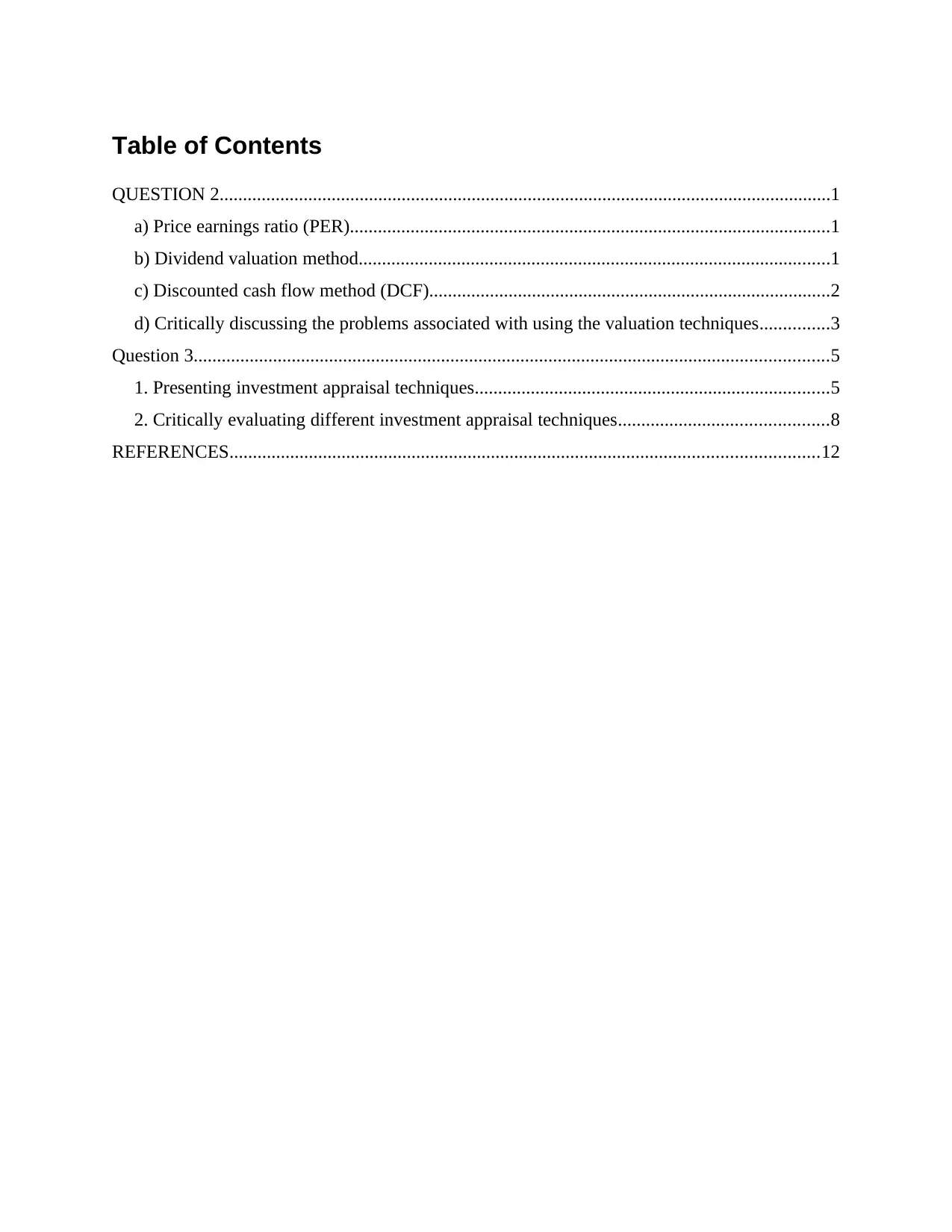
Table of Contents
QUESTION 2...................................................................................................................................1
a) Price earnings ratio (PER).......................................................................................................1
b) Dividend valuation method.....................................................................................................1
c) Discounted cash flow method (DCF)......................................................................................2
d) Critically discussing the problems associated with using the valuation techniques...............3
Question 3........................................................................................................................................5
1. Presenting investment appraisal techniques............................................................................5
2. Critically evaluating different investment appraisal techniques.............................................8
REFERENCES..............................................................................................................................12
QUESTION 2...................................................................................................................................1
a) Price earnings ratio (PER).......................................................................................................1
b) Dividend valuation method.....................................................................................................1
c) Discounted cash flow method (DCF)......................................................................................2
d) Critically discussing the problems associated with using the valuation techniques...............3
Question 3........................................................................................................................................5
1. Presenting investment appraisal techniques............................................................................5
2. Critically evaluating different investment appraisal techniques.............................................8
REFERENCES..............................................................................................................................12
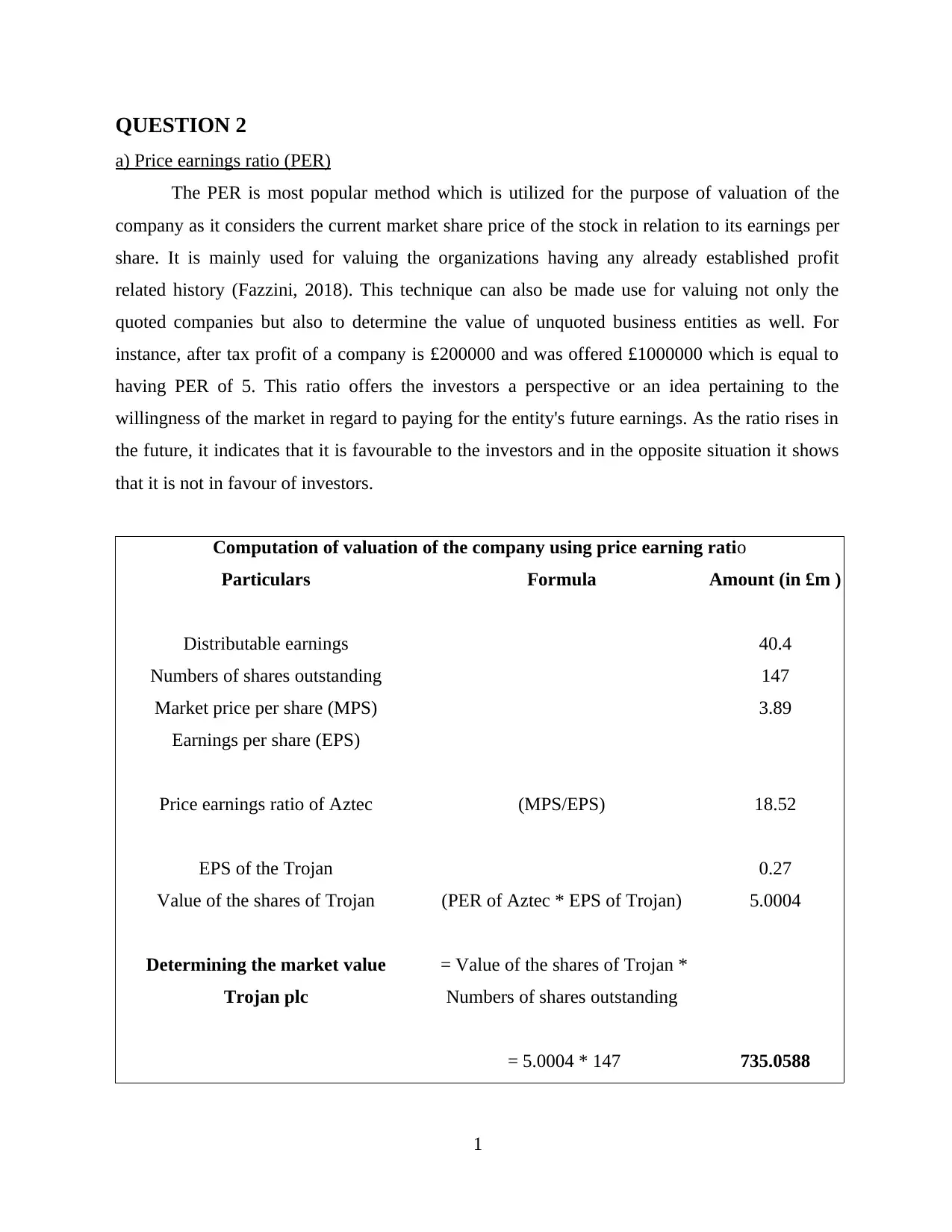
QUESTION 2
a) Price earnings ratio (PER)
The PER is most popular method which is utilized for the purpose of valuation of the
company as it considers the current market share price of the stock in relation to its earnings per
share. It is mainly used for valuing the organizations having any already established profit
related history (Fazzini, 2018). This technique can also be made use for valuing not only the
quoted companies but also to determine the value of unquoted business entities as well. For
instance, after tax profit of a company is £200000 and was offered £1000000 which is equal to
having PER of 5. This ratio offers the investors a perspective or an idea pertaining to the
willingness of the market in regard to paying for the entity's future earnings. As the ratio rises in
the future, it indicates that it is favourable to the investors and in the opposite situation it shows
that it is not in favour of investors.
Computation of valuation of the company using price earning ratio
Particulars Formula Amount (in £m )
Distributable earnings 40.4
Numbers of shares outstanding 147
Market price per share (MPS) 3.89
Earnings per share (EPS)
Price earnings ratio of Aztec (MPS/EPS) 18.52
EPS of the Trojan 0.27
Value of the shares of Trojan (PER of Aztec * EPS of Trojan) 5.0004
Determining the market value
Trojan plc
= Value of the shares of Trojan *
Numbers of shares outstanding
= 5.0004 * 147 735.0588
1
a) Price earnings ratio (PER)
The PER is most popular method which is utilized for the purpose of valuation of the
company as it considers the current market share price of the stock in relation to its earnings per
share. It is mainly used for valuing the organizations having any already established profit
related history (Fazzini, 2018). This technique can also be made use for valuing not only the
quoted companies but also to determine the value of unquoted business entities as well. For
instance, after tax profit of a company is £200000 and was offered £1000000 which is equal to
having PER of 5. This ratio offers the investors a perspective or an idea pertaining to the
willingness of the market in regard to paying for the entity's future earnings. As the ratio rises in
the future, it indicates that it is favourable to the investors and in the opposite situation it shows
that it is not in favour of investors.
Computation of valuation of the company using price earning ratio
Particulars Formula Amount (in £m )
Distributable earnings 40.4
Numbers of shares outstanding 147
Market price per share (MPS) 3.89
Earnings per share (EPS)
Price earnings ratio of Aztec (MPS/EPS) 18.52
EPS of the Trojan 0.27
Value of the shares of Trojan (PER of Aztec * EPS of Trojan) 5.0004
Determining the market value
Trojan plc
= Value of the shares of Trojan *
Numbers of shares outstanding
= 5.0004 * 147 735.0588
1

b) Dividend valuation method
The Gordon's dividend growth model (GGM) is another approach through which the
investor can identify the intrinsic value of the shares of the company on the basis of the constant
growth rate in respect to the dividend. This technique makes use of the dividend growth rate and
the entity's rate of return (ROR). It is based on the dividend discount model but it differs on
account of the fact that GGM assumes that dividend grows at the constant rate (Yu, Assad and
Fuller, 2016). The growth rate can be evaluated through making a multiplication of ROE with
the retention ratio. It provides assistance to the investors in determining whether it is viable to
make an investment in the respected company or not. It provides a clear relationship between the
return and the valuation. This technique is most suitable for business organization with the stable
earnings or the cash flows.
Computation of valuation of the company using Dividend valuation method
Particulars Formula Amount (in £m )
Information provided:
Latest dividend payment (Current
dividend) 0.13
Growth rate (GR)
= 0.10(1+g)^5 = 0.13
= 0.05 5.00%
Risk free rate (Rf) 5.00%
Beta (β) 1.10%
Number of shares 147
Return on market (Rm) 11.00%
For determining expected rate of return
(K), CAPM model will be used
According to CAPM, K is = Rf + (Rm-Rf)β
2
The Gordon's dividend growth model (GGM) is another approach through which the
investor can identify the intrinsic value of the shares of the company on the basis of the constant
growth rate in respect to the dividend. This technique makes use of the dividend growth rate and
the entity's rate of return (ROR). It is based on the dividend discount model but it differs on
account of the fact that GGM assumes that dividend grows at the constant rate (Yu, Assad and
Fuller, 2016). The growth rate can be evaluated through making a multiplication of ROE with
the retention ratio. It provides assistance to the investors in determining whether it is viable to
make an investment in the respected company or not. It provides a clear relationship between the
return and the valuation. This technique is most suitable for business organization with the stable
earnings or the cash flows.
Computation of valuation of the company using Dividend valuation method
Particulars Formula Amount (in £m )
Information provided:
Latest dividend payment (Current
dividend) 0.13
Growth rate (GR)
= 0.10(1+g)^5 = 0.13
= 0.05 5.00%
Risk free rate (Rf) 5.00%
Beta (β) 1.10%
Number of shares 147
Return on market (Rm) 11.00%
For determining expected rate of return
(K), CAPM model will be used
According to CAPM, K is = Rf + (Rm-Rf)β
2
Secure Best Marks with AI Grader
Need help grading? Try our AI Grader for instant feedback on your assignments.
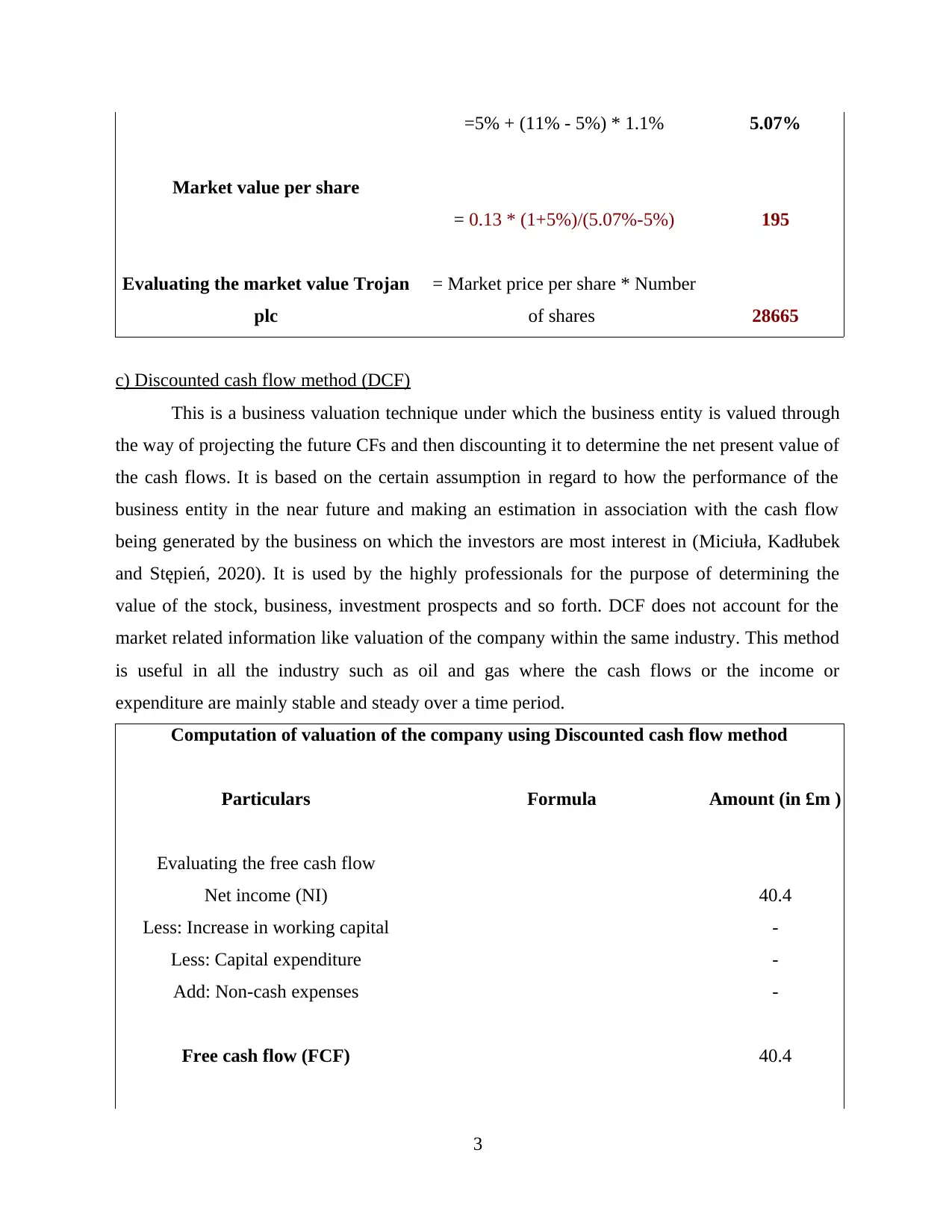
=5% + (11% - 5%) * 1.1% 5.07%
Market value per share
= 0.13 * (1+5%)/(5.07%-5%) 195
Evaluating the market value Trojan
plc
= Market price per share * Number
of shares 28665
c) Discounted cash flow method (DCF)
This is a business valuation technique under which the business entity is valued through
the way of projecting the future CFs and then discounting it to determine the net present value of
the cash flows. It is based on the certain assumption in regard to how the performance of the
business entity in the near future and making an estimation in association with the cash flow
being generated by the business on which the investors are most interest in (Miciuła, Kadłubek
and Stępień, 2020). It is used by the highly professionals for the purpose of determining the
value of the stock, business, investment prospects and so forth. DCF does not account for the
market related information like valuation of the company within the same industry. This method
is useful in all the industry such as oil and gas where the cash flows or the income or
expenditure are mainly stable and steady over a time period.
Computation of valuation of the company using Discounted cash flow method
Particulars Formula Amount (in £m )
Evaluating the free cash flow
Net income (NI) 40.4
Less: Increase in working capital -
Less: Capital expenditure -
Add: Non-cash expenses -
Free cash flow (FCF) 40.4
3
Market value per share
= 0.13 * (1+5%)/(5.07%-5%) 195
Evaluating the market value Trojan
plc
= Market price per share * Number
of shares 28665
c) Discounted cash flow method (DCF)
This is a business valuation technique under which the business entity is valued through
the way of projecting the future CFs and then discounting it to determine the net present value of
the cash flows. It is based on the certain assumption in regard to how the performance of the
business entity in the near future and making an estimation in association with the cash flow
being generated by the business on which the investors are most interest in (Miciuła, Kadłubek
and Stępień, 2020). It is used by the highly professionals for the purpose of determining the
value of the stock, business, investment prospects and so forth. DCF does not account for the
market related information like valuation of the company within the same industry. This method
is useful in all the industry such as oil and gas where the cash flows or the income or
expenditure are mainly stable and steady over a time period.
Computation of valuation of the company using Discounted cash flow method
Particulars Formula Amount (in £m )
Evaluating the free cash flow
Net income (NI) 40.4
Less: Increase in working capital -
Less: Capital expenditure -
Add: Non-cash expenses -
Free cash flow (FCF) 40.4
3
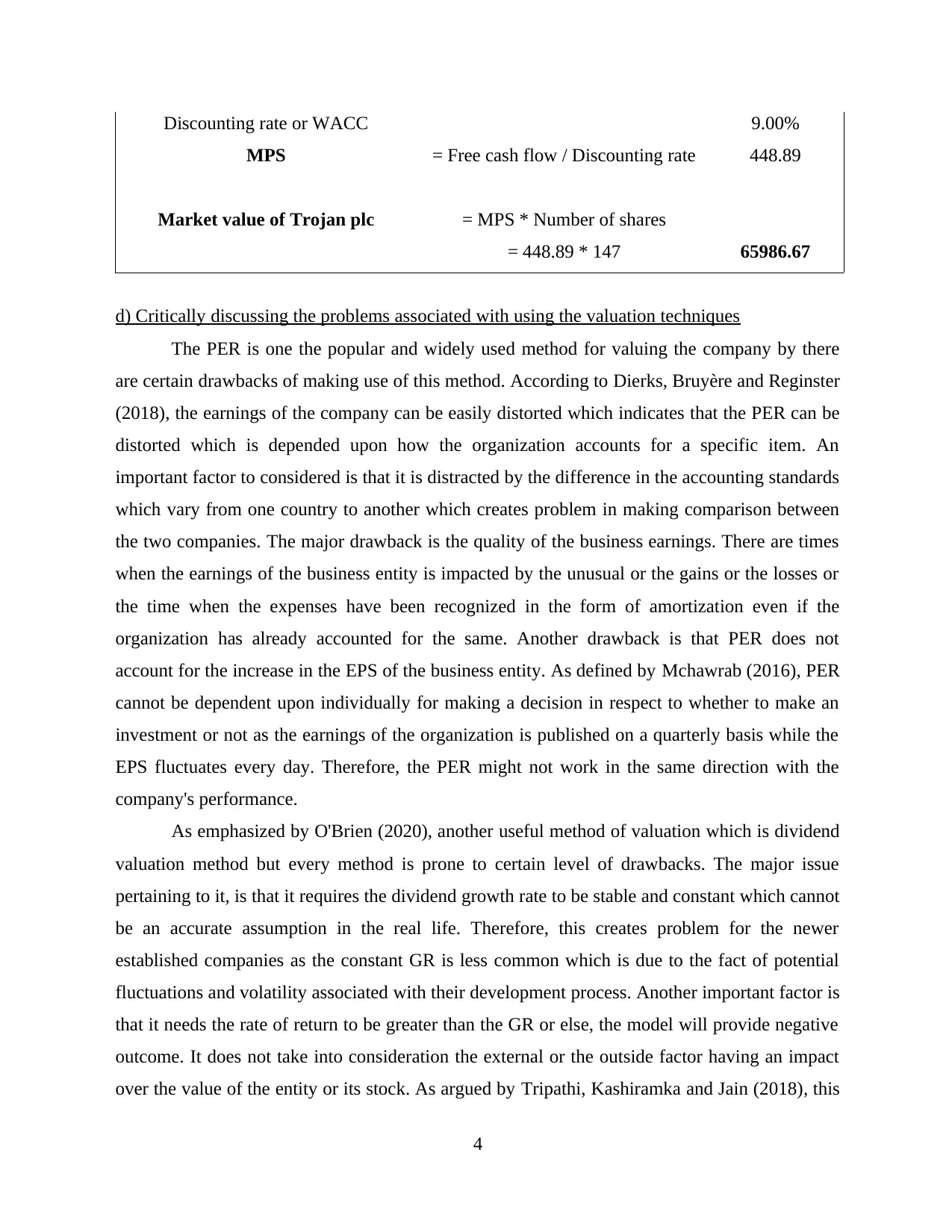
Discounting rate or WACC 9.00%
MPS = Free cash flow / Discounting rate 448.89
Market value of Trojan plc = MPS * Number of shares
= 448.89 * 147 65986.67
d) Critically discussing the problems associated with using the valuation techniques
The PER is one the popular and widely used method for valuing the company by there
are certain drawbacks of making use of this method. According to Dierks, Bruyère and Reginster
(2018), the earnings of the company can be easily distorted which indicates that the PER can be
distorted which is depended upon how the organization accounts for a specific item. An
important factor to considered is that it is distracted by the difference in the accounting standards
which vary from one country to another which creates problem in making comparison between
the two companies. The major drawback is the quality of the business earnings. There are times
when the earnings of the business entity is impacted by the unusual or the gains or the losses or
the time when the expenses have been recognized in the form of amortization even if the
organization has already accounted for the same. Another drawback is that PER does not
account for the increase in the EPS of the business entity. As defined by Mchawrab (2016), PER
cannot be dependent upon individually for making a decision in respect to whether to make an
investment or not as the earnings of the organization is published on a quarterly basis while the
EPS fluctuates every day. Therefore, the PER might not work in the same direction with the
company's performance.
As emphasized by O'Brien (2020), another useful method of valuation which is dividend
valuation method but every method is prone to certain level of drawbacks. The major issue
pertaining to it, is that it requires the dividend growth rate to be stable and constant which cannot
be an accurate assumption in the real life. Therefore, this creates problem for the newer
established companies as the constant GR is less common which is due to the fact of potential
fluctuations and volatility associated with their development process. Another important factor is
that it needs the rate of return to be greater than the GR or else, the model will provide negative
outcome. It does not take into consideration the external or the outside factor having an impact
over the value of the entity or its stock. As argued by Tripathi, Kashiramka and Jain (2018), this
4
MPS = Free cash flow / Discounting rate 448.89
Market value of Trojan plc = MPS * Number of shares
= 448.89 * 147 65986.67
d) Critically discussing the problems associated with using the valuation techniques
The PER is one the popular and widely used method for valuing the company by there
are certain drawbacks of making use of this method. According to Dierks, Bruyère and Reginster
(2018), the earnings of the company can be easily distorted which indicates that the PER can be
distorted which is depended upon how the organization accounts for a specific item. An
important factor to considered is that it is distracted by the difference in the accounting standards
which vary from one country to another which creates problem in making comparison between
the two companies. The major drawback is the quality of the business earnings. There are times
when the earnings of the business entity is impacted by the unusual or the gains or the losses or
the time when the expenses have been recognized in the form of amortization even if the
organization has already accounted for the same. Another drawback is that PER does not
account for the increase in the EPS of the business entity. As defined by Mchawrab (2016), PER
cannot be dependent upon individually for making a decision in respect to whether to make an
investment or not as the earnings of the organization is published on a quarterly basis while the
EPS fluctuates every day. Therefore, the PER might not work in the same direction with the
company's performance.
As emphasized by O'Brien (2020), another useful method of valuation which is dividend
valuation method but every method is prone to certain level of drawbacks. The major issue
pertaining to it, is that it requires the dividend growth rate to be stable and constant which cannot
be an accurate assumption in the real life. Therefore, this creates problem for the newer
established companies as the constant GR is less common which is due to the fact of potential
fluctuations and volatility associated with their development process. Another important factor is
that it needs the rate of return to be greater than the GR or else, the model will provide negative
outcome. It does not take into consideration the external or the outside factor having an impact
over the value of the entity or its stock. As argued by Tripathi, Kashiramka and Jain (2018), this
4
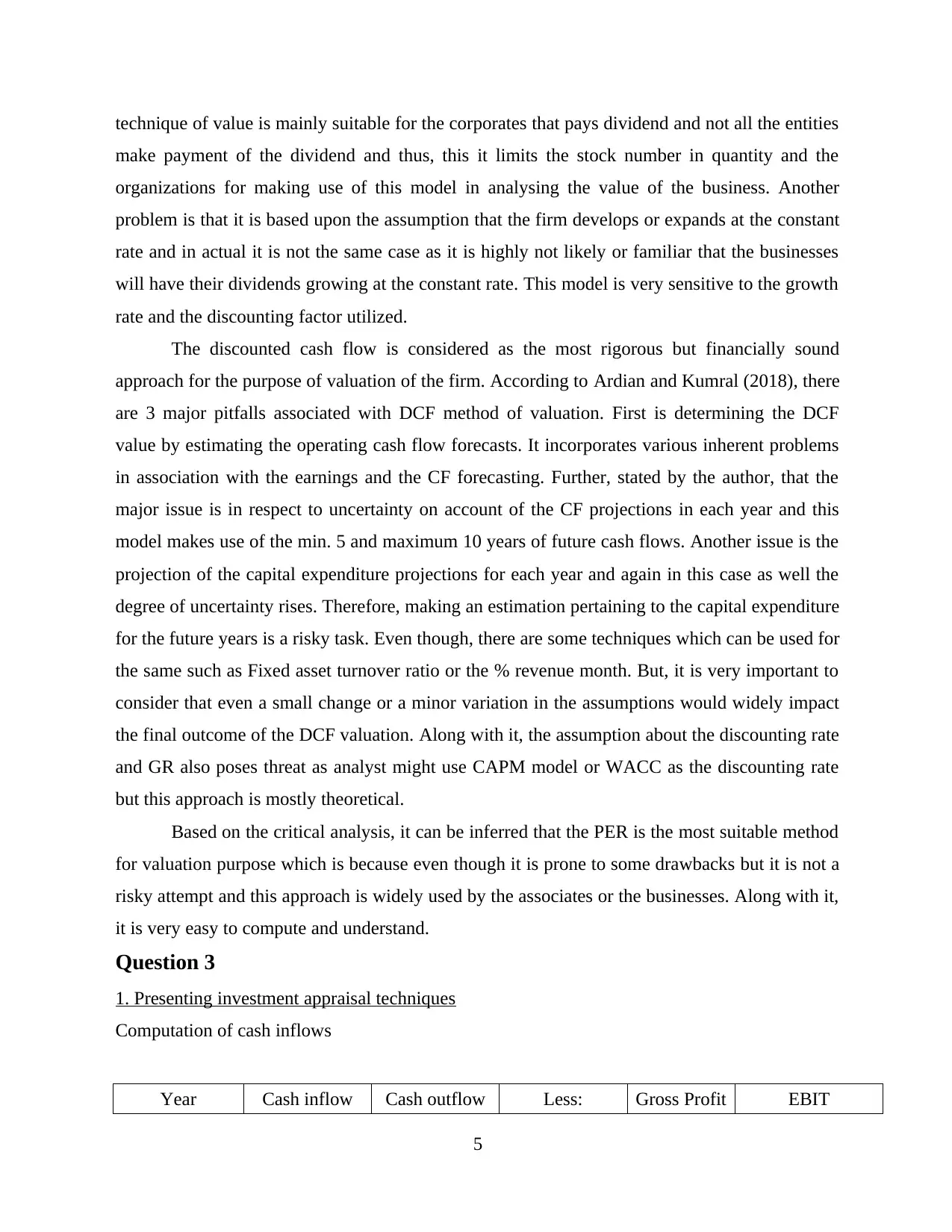
technique of value is mainly suitable for the corporates that pays dividend and not all the entities
make payment of the dividend and thus, this it limits the stock number in quantity and the
organizations for making use of this model in analysing the value of the business. Another
problem is that it is based upon the assumption that the firm develops or expands at the constant
rate and in actual it is not the same case as it is highly not likely or familiar that the businesses
will have their dividends growing at the constant rate. This model is very sensitive to the growth
rate and the discounting factor utilized.
The discounted cash flow is considered as the most rigorous but financially sound
approach for the purpose of valuation of the firm. According to Ardian and Kumral (2018), there
are 3 major pitfalls associated with DCF method of valuation. First is determining the DCF
value by estimating the operating cash flow forecasts. It incorporates various inherent problems
in association with the earnings and the CF forecasting. Further, stated by the author, that the
major issue is in respect to uncertainty on account of the CF projections in each year and this
model makes use of the min. 5 and maximum 10 years of future cash flows. Another issue is the
projection of the capital expenditure projections for each year and again in this case as well the
degree of uncertainty rises. Therefore, making an estimation pertaining to the capital expenditure
for the future years is a risky task. Even though, there are some techniques which can be used for
the same such as Fixed asset turnover ratio or the % revenue month. But, it is very important to
consider that even a small change or a minor variation in the assumptions would widely impact
the final outcome of the DCF valuation. Along with it, the assumption about the discounting rate
and GR also poses threat as analyst might use CAPM model or WACC as the discounting rate
but this approach is mostly theoretical.
Based on the critical analysis, it can be inferred that the PER is the most suitable method
for valuation purpose which is because even though it is prone to some drawbacks but it is not a
risky attempt and this approach is widely used by the associates or the businesses. Along with it,
it is very easy to compute and understand.
Question 3
1. Presenting investment appraisal techniques
Computation of cash inflows
Year Cash inflow Cash outflow Less: Gross Profit EBIT
5
make payment of the dividend and thus, this it limits the stock number in quantity and the
organizations for making use of this model in analysing the value of the business. Another
problem is that it is based upon the assumption that the firm develops or expands at the constant
rate and in actual it is not the same case as it is highly not likely or familiar that the businesses
will have their dividends growing at the constant rate. This model is very sensitive to the growth
rate and the discounting factor utilized.
The discounted cash flow is considered as the most rigorous but financially sound
approach for the purpose of valuation of the firm. According to Ardian and Kumral (2018), there
are 3 major pitfalls associated with DCF method of valuation. First is determining the DCF
value by estimating the operating cash flow forecasts. It incorporates various inherent problems
in association with the earnings and the CF forecasting. Further, stated by the author, that the
major issue is in respect to uncertainty on account of the CF projections in each year and this
model makes use of the min. 5 and maximum 10 years of future cash flows. Another issue is the
projection of the capital expenditure projections for each year and again in this case as well the
degree of uncertainty rises. Therefore, making an estimation pertaining to the capital expenditure
for the future years is a risky task. Even though, there are some techniques which can be used for
the same such as Fixed asset turnover ratio or the % revenue month. But, it is very important to
consider that even a small change or a minor variation in the assumptions would widely impact
the final outcome of the DCF valuation. Along with it, the assumption about the discounting rate
and GR also poses threat as analyst might use CAPM model or WACC as the discounting rate
but this approach is mostly theoretical.
Based on the critical analysis, it can be inferred that the PER is the most suitable method
for valuation purpose which is because even though it is prone to some drawbacks but it is not a
risky attempt and this approach is widely used by the associates or the businesses. Along with it,
it is very easy to compute and understand.
Question 3
1. Presenting investment appraisal techniques
Computation of cash inflows
Year Cash inflow Cash outflow Less: Gross Profit EBIT
5
Paraphrase This Document
Need a fresh take? Get an instant paraphrase of this document with our AI Paraphraser
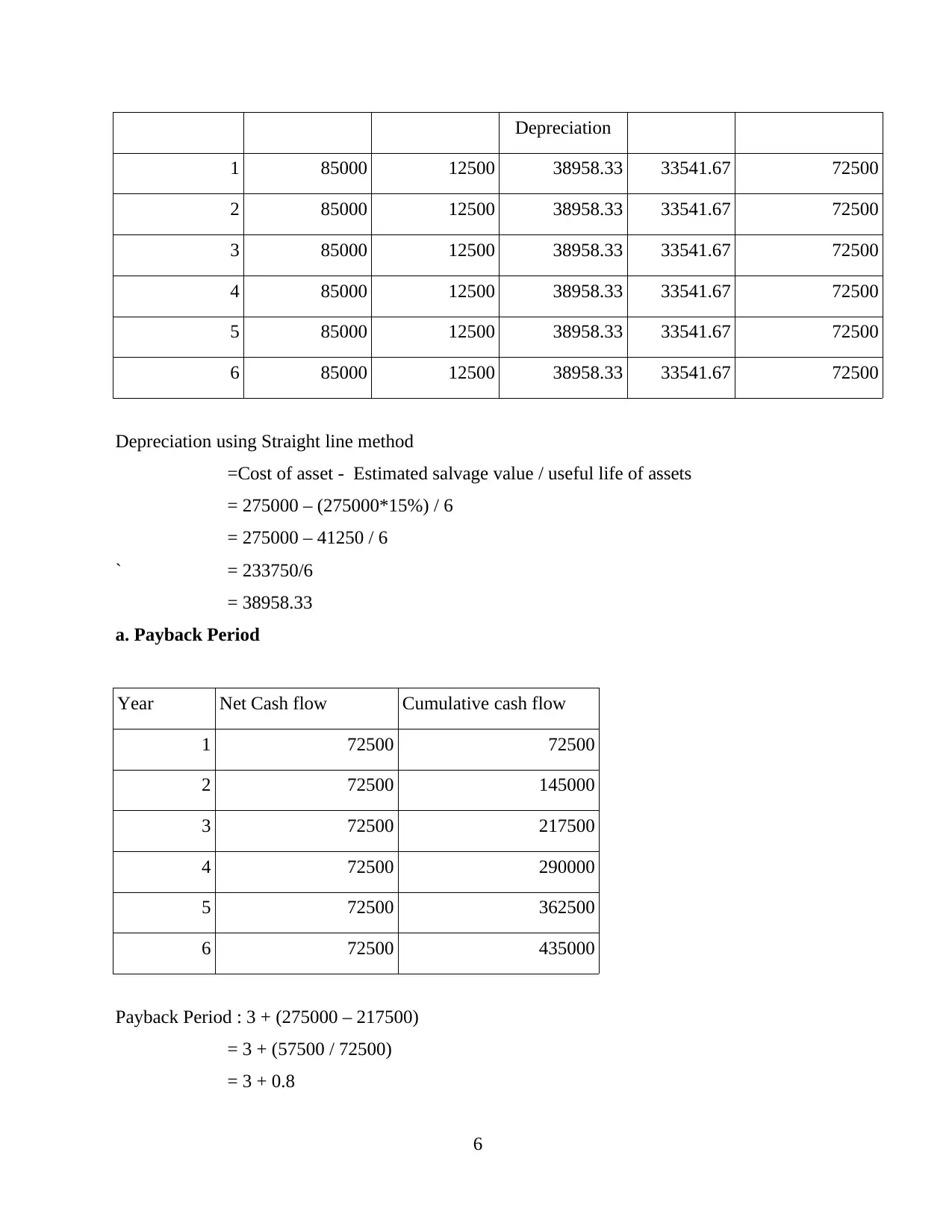
Depreciation
1 85000 12500 38958.33 33541.67 72500
2 85000 12500 38958.33 33541.67 72500
3 85000 12500 38958.33 33541.67 72500
4 85000 12500 38958.33 33541.67 72500
5 85000 12500 38958.33 33541.67 72500
6 85000 12500 38958.33 33541.67 72500
Depreciation using Straight line method
=Cost of asset - Estimated salvage value / useful life of assets
= 275000 – (275000*15%) / 6
= 275000 – 41250 / 6
` = 233750/6
= 38958.33
a. Payback Period
Year Net Cash flow Cumulative cash flow
1 72500 72500
2 72500 145000
3 72500 217500
4 72500 290000
5 72500 362500
6 72500 435000
Payback Period : 3 + (275000 – 217500)
= 3 + (57500 / 72500)
= 3 + 0.8
6
1 85000 12500 38958.33 33541.67 72500
2 85000 12500 38958.33 33541.67 72500
3 85000 12500 38958.33 33541.67 72500
4 85000 12500 38958.33 33541.67 72500
5 85000 12500 38958.33 33541.67 72500
6 85000 12500 38958.33 33541.67 72500
Depreciation using Straight line method
=Cost of asset - Estimated salvage value / useful life of assets
= 275000 – (275000*15%) / 6
= 275000 – 41250 / 6
` = 233750/6
= 38958.33
a. Payback Period
Year Net Cash flow Cumulative cash flow
1 72500 72500
2 72500 145000
3 72500 217500
4 72500 290000
5 72500 362500
6 72500 435000
Payback Period : 3 + (275000 – 217500)
= 3 + (57500 / 72500)
= 3 + 0.8
6
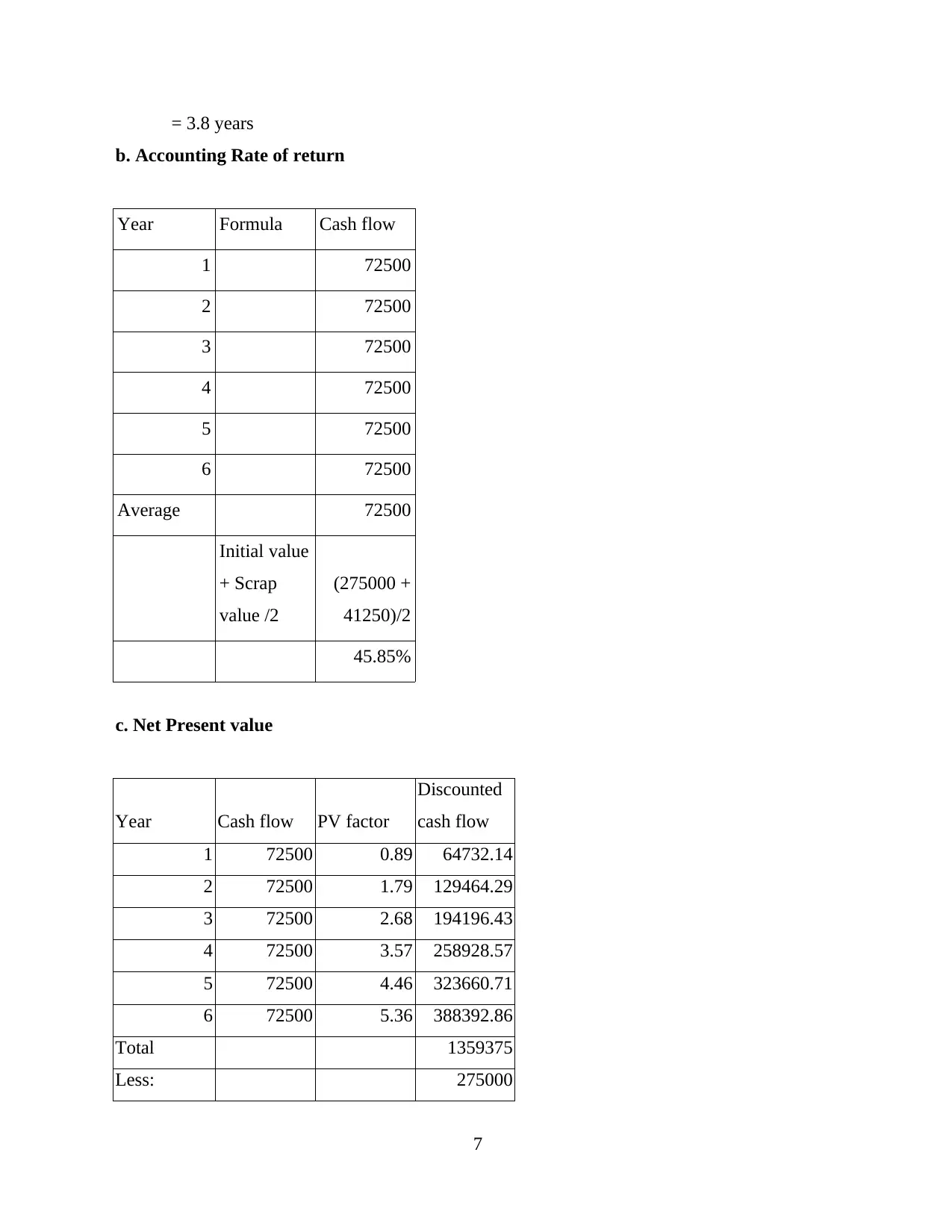
= 3.8 years
b. Accounting Rate of return
Year Formula Cash flow
1 72500
2 72500
3 72500
4 72500
5 72500
6 72500
Average 72500
Initial value
+ Scrap
value /2
(275000 +
41250)/2
45.85%
c. Net Present value
Year Cash flow PV factor
Discounted
cash flow
1 72500 0.89 64732.14
2 72500 1.79 129464.29
3 72500 2.68 194196.43
4 72500 3.57 258928.57
5 72500 4.46 323660.71
6 72500 5.36 388392.86
Total 1359375
Less: 275000
7
b. Accounting Rate of return
Year Formula Cash flow
1 72500
2 72500
3 72500
4 72500
5 72500
6 72500
Average 72500
Initial value
+ Scrap
value /2
(275000 +
41250)/2
45.85%
c. Net Present value
Year Cash flow PV factor
Discounted
cash flow
1 72500 0.89 64732.14
2 72500 1.79 129464.29
3 72500 2.68 194196.43
4 72500 3.57 258928.57
5 72500 4.46 323660.71
6 72500 5.36 388392.86
Total 1359375
Less: 275000
7
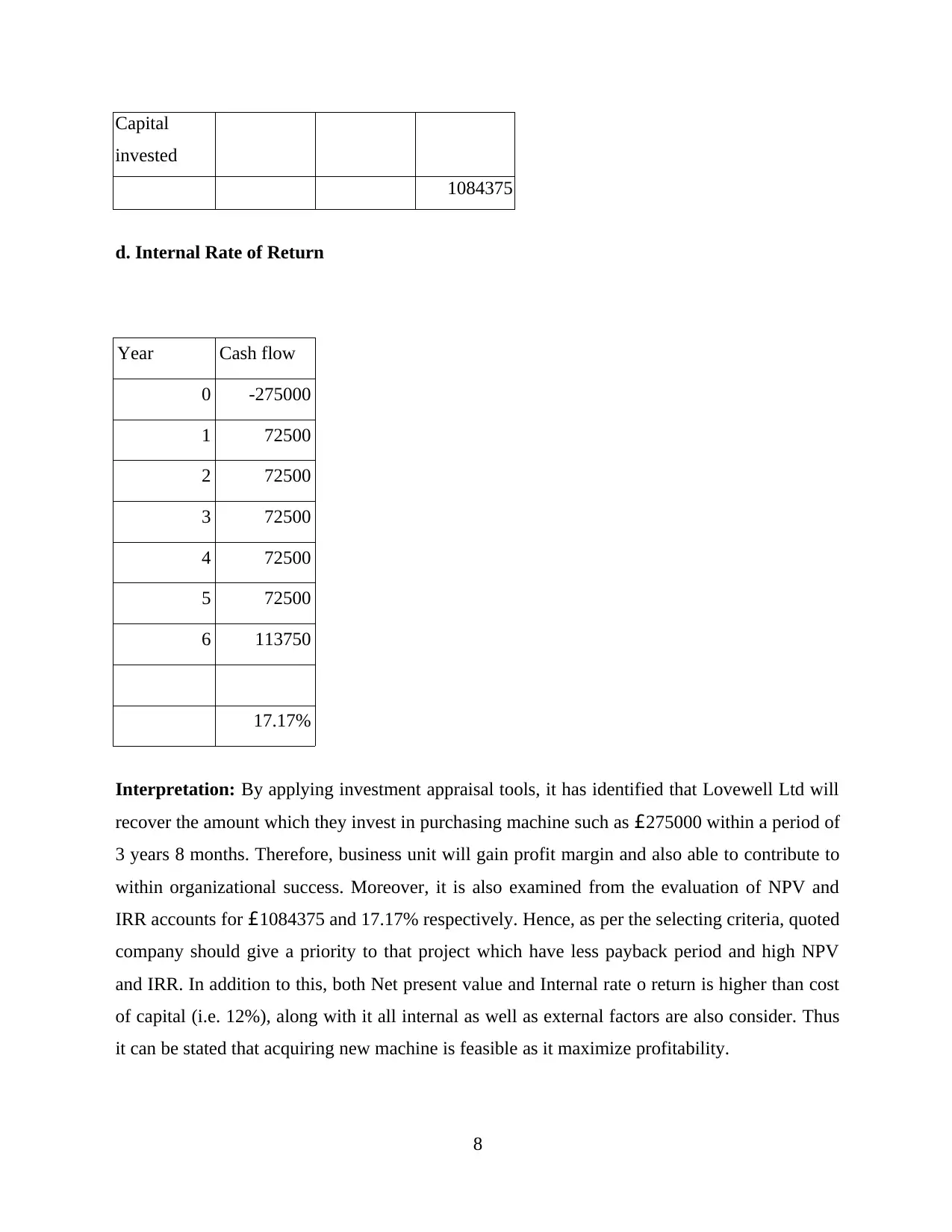
Capital
invested
1084375
d. Internal Rate of Return
Year Cash flow
0 -275000
1 72500
2 72500
3 72500
4 72500
5 72500
6 113750
17.17%
Interpretation: By applying investment appraisal tools, it has identified that Lovewell Ltd will
recover the amount which they invest in purchasing machine such as £275000 within a period of
3 years 8 months. Therefore, business unit will gain profit margin and also able to contribute to
within organizational success. Moreover, it is also examined from the evaluation of NPV and
IRR accounts for £1084375 and 17.17% respectively. Hence, as per the selecting criteria, quoted
company should give a priority to that project which have less payback period and high NPV
and IRR. In addition to this, both Net present value and Internal rate o return is higher than cost
of capital (i.e. 12%), along with it all internal as well as external factors are also consider. Thus
it can be stated that acquiring new machine is feasible as it maximize profitability.
8
invested
1084375
d. Internal Rate of Return
Year Cash flow
0 -275000
1 72500
2 72500
3 72500
4 72500
5 72500
6 113750
17.17%
Interpretation: By applying investment appraisal tools, it has identified that Lovewell Ltd will
recover the amount which they invest in purchasing machine such as £275000 within a period of
3 years 8 months. Therefore, business unit will gain profit margin and also able to contribute to
within organizational success. Moreover, it is also examined from the evaluation of NPV and
IRR accounts for £1084375 and 17.17% respectively. Hence, as per the selecting criteria, quoted
company should give a priority to that project which have less payback period and high NPV
and IRR. In addition to this, both Net present value and Internal rate o return is higher than cost
of capital (i.e. 12%), along with it all internal as well as external factors are also consider. Thus
it can be stated that acquiring new machine is feasible as it maximize profitability.
8
Secure Best Marks with AI Grader
Need help grading? Try our AI Grader for instant feedback on your assignments.

So, in the context of current evaluation, it can be entailed that investing in new machine
will help company in attaining the set aim and objectives because ARR is higher which clearly
reflected that company earn profit.
2. Critically evaluating different investment appraisal techniques
Payback Period (PBP):
It is refers to the amount of time which takes to recover the cost of an investment. Thus,
it is length of the time, in which an investment reaches to a break even point. In this technique,
the shorter payback are considered more attractive investment rather than larger one (Gorshkov,
Murgul and Oliynyk, 2016). Payback period also ignores the concept of time value of money,
but is used in combination with other techniques of capital budgeting. Also, the main purpose of
using this tool is to compare similar investment and identify which is more beneficial for a
business.
Advantages:
Payback Period method is simple to use and easy to understand among all others. It is so
because only project's initial cost and annual cash flows are calculating.
It assist to generate quick solution because it needs fewer inputs and this in turn assist to
those companies who have limited resources.
Also provide crucial information which no other capital budgeting method reveals. The method is more suitable in those industries who have to cope up with rapid
technological changes. Therefore, it aid to reduce the chances of loss through
obsolescence.
Disadvantages:
It ignore time value of money which is quite important for business concept. As a result,
PBP distorting the true value of cash flows (Siecker, Kusakana and Numbi, 2018).
The method is consider cash flows till investment is recovered. Also, it is simple to use
but not realistic, that is why, normal business do not consider the same. There is no surety that project with shorter PBP will be profitable. It is so because it
neglects project's Return on investment (ROI).
Accounting rate of return (ARR):
9
will help company in attaining the set aim and objectives because ARR is higher which clearly
reflected that company earn profit.
2. Critically evaluating different investment appraisal techniques
Payback Period (PBP):
It is refers to the amount of time which takes to recover the cost of an investment. Thus,
it is length of the time, in which an investment reaches to a break even point. In this technique,
the shorter payback are considered more attractive investment rather than larger one (Gorshkov,
Murgul and Oliynyk, 2016). Payback period also ignores the concept of time value of money,
but is used in combination with other techniques of capital budgeting. Also, the main purpose of
using this tool is to compare similar investment and identify which is more beneficial for a
business.
Advantages:
Payback Period method is simple to use and easy to understand among all others. It is so
because only project's initial cost and annual cash flows are calculating.
It assist to generate quick solution because it needs fewer inputs and this in turn assist to
those companies who have limited resources.
Also provide crucial information which no other capital budgeting method reveals. The method is more suitable in those industries who have to cope up with rapid
technological changes. Therefore, it aid to reduce the chances of loss through
obsolescence.
Disadvantages:
It ignore time value of money which is quite important for business concept. As a result,
PBP distorting the true value of cash flows (Siecker, Kusakana and Numbi, 2018).
The method is consider cash flows till investment is recovered. Also, it is simple to use
but not realistic, that is why, normal business do not consider the same. There is no surety that project with shorter PBP will be profitable. It is so because it
neglects project's Return on investment (ROI).
Accounting rate of return (ARR):
9
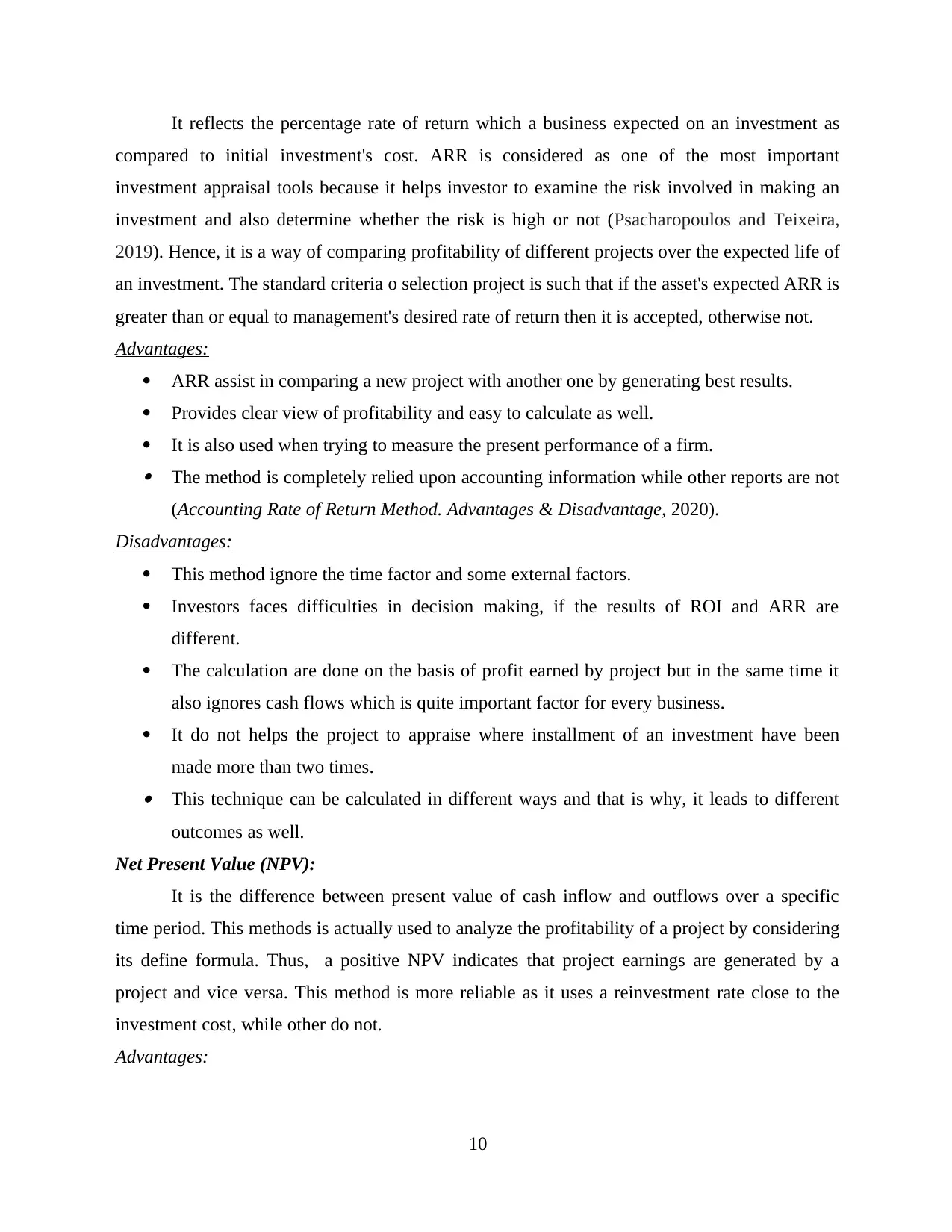
It reflects the percentage rate of return which a business expected on an investment as
compared to initial investment's cost. ARR is considered as one of the most important
investment appraisal tools because it helps investor to examine the risk involved in making an
investment and also determine whether the risk is high or not (Psacharopoulos and Teixeira,
2019). Hence, it is a way of comparing profitability of different projects over the expected life of
an investment. The standard criteria o selection project is such that if the asset's expected ARR is
greater than or equal to management's desired rate of return then it is accepted, otherwise not.
Advantages:
ARR assist in comparing a new project with another one by generating best results.
Provides clear view of profitability and easy to calculate as well.
It is also used when trying to measure the present performance of a firm. The method is completely relied upon accounting information while other reports are not
(Accounting Rate of Return Method. Advantages & Disadvantage, 2020).
Disadvantages:
This method ignore the time factor and some external factors.
Investors faces difficulties in decision making, if the results of ROI and ARR are
different.
The calculation are done on the basis of profit earned by project but in the same time it
also ignores cash flows which is quite important factor for every business.
It do not helps the project to appraise where installment of an investment have been
made more than two times. This technique can be calculated in different ways and that is why, it leads to different
outcomes as well.
Net Present Value (NPV):
It is the difference between present value of cash inflow and outflows over a specific
time period. This methods is actually used to analyze the profitability of a project by considering
its define formula. Thus, a positive NPV indicates that project earnings are generated by a
project and vice versa. This method is more reliable as it uses a reinvestment rate close to the
investment cost, while other do not.
Advantages:
10
compared to initial investment's cost. ARR is considered as one of the most important
investment appraisal tools because it helps investor to examine the risk involved in making an
investment and also determine whether the risk is high or not (Psacharopoulos and Teixeira,
2019). Hence, it is a way of comparing profitability of different projects over the expected life of
an investment. The standard criteria o selection project is such that if the asset's expected ARR is
greater than or equal to management's desired rate of return then it is accepted, otherwise not.
Advantages:
ARR assist in comparing a new project with another one by generating best results.
Provides clear view of profitability and easy to calculate as well.
It is also used when trying to measure the present performance of a firm. The method is completely relied upon accounting information while other reports are not
(Accounting Rate of Return Method. Advantages & Disadvantage, 2020).
Disadvantages:
This method ignore the time factor and some external factors.
Investors faces difficulties in decision making, if the results of ROI and ARR are
different.
The calculation are done on the basis of profit earned by project but in the same time it
also ignores cash flows which is quite important factor for every business.
It do not helps the project to appraise where installment of an investment have been
made more than two times. This technique can be calculated in different ways and that is why, it leads to different
outcomes as well.
Net Present Value (NPV):
It is the difference between present value of cash inflow and outflows over a specific
time period. This methods is actually used to analyze the profitability of a project by considering
its define formula. Thus, a positive NPV indicates that project earnings are generated by a
project and vice versa. This method is more reliable as it uses a reinvestment rate close to the
investment cost, while other do not.
Advantages:
10
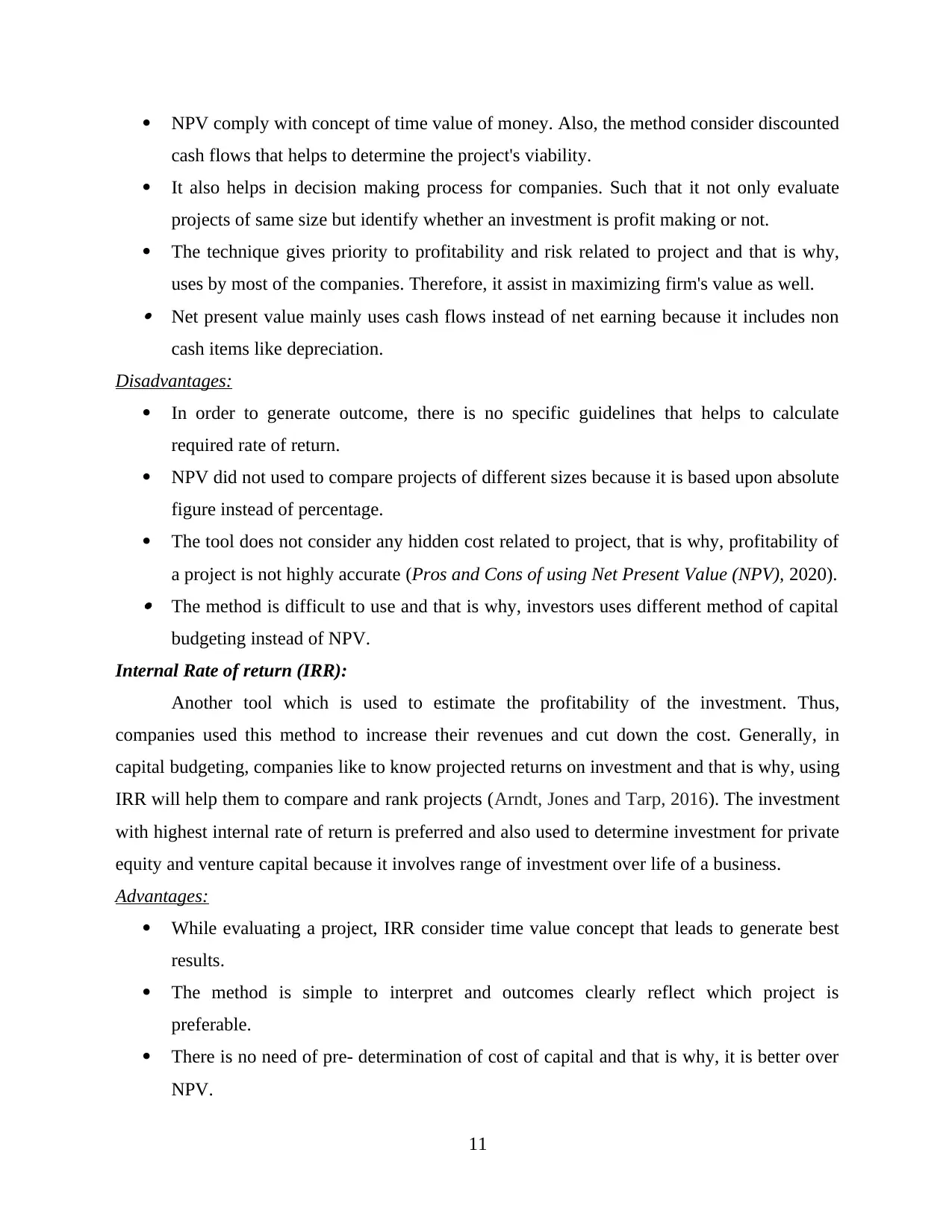
NPV comply with concept of time value of money. Also, the method consider discounted
cash flows that helps to determine the project's viability.
It also helps in decision making process for companies. Such that it not only evaluate
projects of same size but identify whether an investment is profit making or not.
The technique gives priority to profitability and risk related to project and that is why,
uses by most of the companies. Therefore, it assist in maximizing firm's value as well. Net present value mainly uses cash flows instead of net earning because it includes non
cash items like depreciation.
Disadvantages:
In order to generate outcome, there is no specific guidelines that helps to calculate
required rate of return.
NPV did not used to compare projects of different sizes because it is based upon absolute
figure instead of percentage.
The tool does not consider any hidden cost related to project, that is why, profitability of
a project is not highly accurate (Pros and Cons of using Net Present Value (NPV), 2020). The method is difficult to use and that is why, investors uses different method of capital
budgeting instead of NPV.
Internal Rate of return (IRR):
Another tool which is used to estimate the profitability of the investment. Thus,
companies used this method to increase their revenues and cut down the cost. Generally, in
capital budgeting, companies like to know projected returns on investment and that is why, using
IRR will help them to compare and rank projects (Arndt, Jones and Tarp, 2016). The investment
with highest internal rate of return is preferred and also used to determine investment for private
equity and venture capital because it involves range of investment over life of a business.
Advantages:
While evaluating a project, IRR consider time value concept that leads to generate best
results.
The method is simple to interpret and outcomes clearly reflect which project is
preferable.
There is no need of pre- determination of cost of capital and that is why, it is better over
NPV.
11
cash flows that helps to determine the project's viability.
It also helps in decision making process for companies. Such that it not only evaluate
projects of same size but identify whether an investment is profit making or not.
The technique gives priority to profitability and risk related to project and that is why,
uses by most of the companies. Therefore, it assist in maximizing firm's value as well. Net present value mainly uses cash flows instead of net earning because it includes non
cash items like depreciation.
Disadvantages:
In order to generate outcome, there is no specific guidelines that helps to calculate
required rate of return.
NPV did not used to compare projects of different sizes because it is based upon absolute
figure instead of percentage.
The tool does not consider any hidden cost related to project, that is why, profitability of
a project is not highly accurate (Pros and Cons of using Net Present Value (NPV), 2020). The method is difficult to use and that is why, investors uses different method of capital
budgeting instead of NPV.
Internal Rate of return (IRR):
Another tool which is used to estimate the profitability of the investment. Thus,
companies used this method to increase their revenues and cut down the cost. Generally, in
capital budgeting, companies like to know projected returns on investment and that is why, using
IRR will help them to compare and rank projects (Arndt, Jones and Tarp, 2016). The investment
with highest internal rate of return is preferred and also used to determine investment for private
equity and venture capital because it involves range of investment over life of a business.
Advantages:
While evaluating a project, IRR consider time value concept that leads to generate best
results.
The method is simple to interpret and outcomes clearly reflect which project is
preferable.
There is no need of pre- determination of cost of capital and that is why, it is better over
NPV.
11
Paraphrase This Document
Need a fresh take? Get an instant paraphrase of this document with our AI Paraphraser
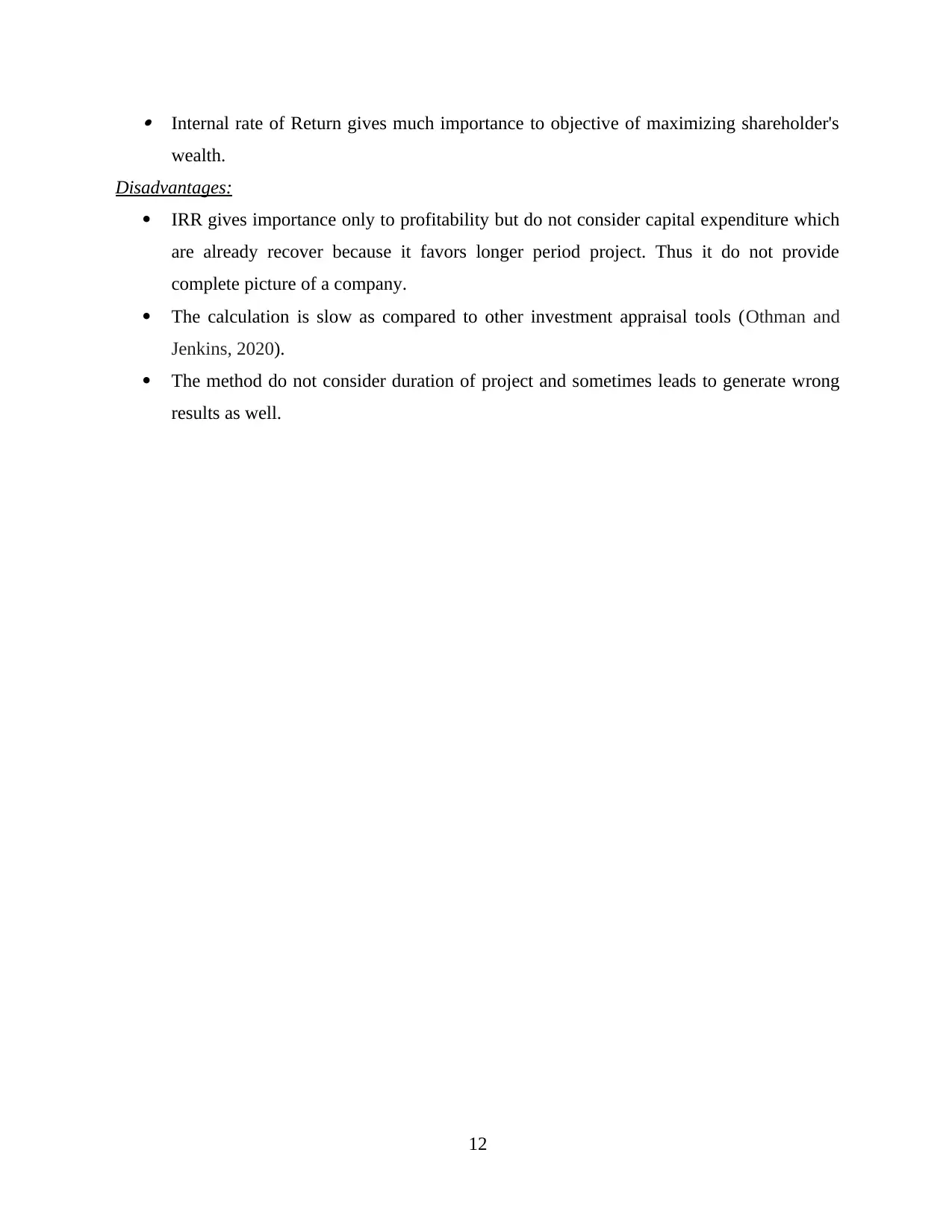
Internal rate of Return gives much importance to objective of maximizing shareholder's
wealth.
Disadvantages:
IRR gives importance only to profitability but do not consider capital expenditure which
are already recover because it favors longer period project. Thus it do not provide
complete picture of a company.
The calculation is slow as compared to other investment appraisal tools (Othman and
Jenkins, 2020).
The method do not consider duration of project and sometimes leads to generate wrong
results as well.
12
wealth.
Disadvantages:
IRR gives importance only to profitability but do not consider capital expenditure which
are already recover because it favors longer period project. Thus it do not provide
complete picture of a company.
The calculation is slow as compared to other investment appraisal tools (Othman and
Jenkins, 2020).
The method do not consider duration of project and sometimes leads to generate wrong
results as well.
12

REFERENCES
Books and Journals
Ardian, A. and Kumral, M., 2018, December. Dynamic discount rate through Ornstein-
Uhlenbeck process for mining project valuation. In IOP Conference Series: Earth and
Environmental Science (Vol. 212, No. 1, p. 012058). IOP Publishing.
Arndt, C., Jones, S. and Tarp, F., 2016. What is the aggregate economic rate of return to foreign
aid?. The World Bank Economic Review.30(3). pp.446-474.
Dierks, R. M. L., Bruyère, O. and Reginster, J. Y., 2018. Critical analysis of valuation and
strategical orientation of merger and acquisition deals in the pharmaceutical
industry. Expert Review of Pharmacoeconomics & Outcomes Research. 18(2). pp.147-
160.
Fazzini, M., 2018. Market-Based Method. In Business Valuation (pp. 123-174). Palgrave
Macmillan, Cham.
Gorshkov, A., Murgul, V. and Oliynyk, O., 2016. Forecasted payback period in the case of
energy-efficient activities. In MATEC Web of Conferences (Vol. 53, p. 01045). EDP
Sciences.
Mchawrab, S., 2016. M&A in the high tech industry: value and valuation. Strategic Direction.
Miciuła, I., Kadłubek, M. and Stępień, P., 2020. Modern Methods of Business Valuation—Case
Study and New Concepts. Sustainability. 12(7). p.2699.
O'Brien, T. J., 2020. International Valuation: A Proposed Method Using the Constant Perpetual
Growth Model. Available at SSRN 3429404.
Othman, A. and Jenkins, G.P., 2020. Estimation of the rate of return to capital in the East
African Community (EAC) Countries. Applied Economics, pp.1-17.
Psacharopoulos, G. and Teixeira, P., 2019. Rates of Return to Education: Conceptual and
Methodological Issues. Encyclopedia of International Higher Education Systems and
Institutions; Springer: Dordrecht, Germany, pp.1-8.
Siecker, J., Kusakana, K. and Numbi, B.P., 2018. Optimal switching control of PV/T systems
with energy storage using forced water circulation: Case of South Africa. Journal of
Energy Storage. 20. pp.264-278.
Tripathi, M., Kashiramka, S. and Jain, P. K., 2018. Equity Risk Premium in India: Comparative
Estimates from Historical Returns, Dividend and Earnings Models. Journal of
Emerging Market Finance. 17(1_suppl). pp.S136-S156.
Yu, G., Assad, J. C. and Fuller, P., 2016. Using a Modified Dividend Discount Model for Stock
Market Games. Yu, Geungu, Jean-Claude Assad, and Phillip Fuller.“Using A Modified
Dividend Discount Model For Stock Market Games.” Southwestern Economic Review,
(Spring 2017). 44(1). pp.29-42.
Online
Pros and Cons of using Net Present Value (NPV). 2020. [Online]. Available through:
<https://forisk.com/blog/2020/05/31/pros-and-cons-of-using-net-present-value-npv/>.
Accounting Rate of Return Method. Advantages & Disadvantage. 2020. [Online]. Available
through: <https://accountlearning.com/accounting-rate-of-return-method-advantages-
disadvantages/>.
13
Books and Journals
Ardian, A. and Kumral, M., 2018, December. Dynamic discount rate through Ornstein-
Uhlenbeck process for mining project valuation. In IOP Conference Series: Earth and
Environmental Science (Vol. 212, No. 1, p. 012058). IOP Publishing.
Arndt, C., Jones, S. and Tarp, F., 2016. What is the aggregate economic rate of return to foreign
aid?. The World Bank Economic Review.30(3). pp.446-474.
Dierks, R. M. L., Bruyère, O. and Reginster, J. Y., 2018. Critical analysis of valuation and
strategical orientation of merger and acquisition deals in the pharmaceutical
industry. Expert Review of Pharmacoeconomics & Outcomes Research. 18(2). pp.147-
160.
Fazzini, M., 2018. Market-Based Method. In Business Valuation (pp. 123-174). Palgrave
Macmillan, Cham.
Gorshkov, A., Murgul, V. and Oliynyk, O., 2016. Forecasted payback period in the case of
energy-efficient activities. In MATEC Web of Conferences (Vol. 53, p. 01045). EDP
Sciences.
Mchawrab, S., 2016. M&A in the high tech industry: value and valuation. Strategic Direction.
Miciuła, I., Kadłubek, M. and Stępień, P., 2020. Modern Methods of Business Valuation—Case
Study and New Concepts. Sustainability. 12(7). p.2699.
O'Brien, T. J., 2020. International Valuation: A Proposed Method Using the Constant Perpetual
Growth Model. Available at SSRN 3429404.
Othman, A. and Jenkins, G.P., 2020. Estimation of the rate of return to capital in the East
African Community (EAC) Countries. Applied Economics, pp.1-17.
Psacharopoulos, G. and Teixeira, P., 2019. Rates of Return to Education: Conceptual and
Methodological Issues. Encyclopedia of International Higher Education Systems and
Institutions; Springer: Dordrecht, Germany, pp.1-8.
Siecker, J., Kusakana, K. and Numbi, B.P., 2018. Optimal switching control of PV/T systems
with energy storage using forced water circulation: Case of South Africa. Journal of
Energy Storage. 20. pp.264-278.
Tripathi, M., Kashiramka, S. and Jain, P. K., 2018. Equity Risk Premium in India: Comparative
Estimates from Historical Returns, Dividend and Earnings Models. Journal of
Emerging Market Finance. 17(1_suppl). pp.S136-S156.
Yu, G., Assad, J. C. and Fuller, P., 2016. Using a Modified Dividend Discount Model for Stock
Market Games. Yu, Geungu, Jean-Claude Assad, and Phillip Fuller.“Using A Modified
Dividend Discount Model For Stock Market Games.” Southwestern Economic Review,
(Spring 2017). 44(1). pp.29-42.
Online
Pros and Cons of using Net Present Value (NPV). 2020. [Online]. Available through:
<https://forisk.com/blog/2020/05/31/pros-and-cons-of-using-net-present-value-npv/>.
Accounting Rate of Return Method. Advantages & Disadvantage. 2020. [Online]. Available
through: <https://accountlearning.com/accounting-rate-of-return-method-advantages-
disadvantages/>.
13
1 out of 15
Related Documents
Your All-in-One AI-Powered Toolkit for Academic Success.
+13062052269
info@desklib.com
Available 24*7 on WhatsApp / Email
![[object Object]](/_next/static/media/star-bottom.7253800d.svg)
Unlock your academic potential
© 2024 | Zucol Services PVT LTD | All rights reserved.





